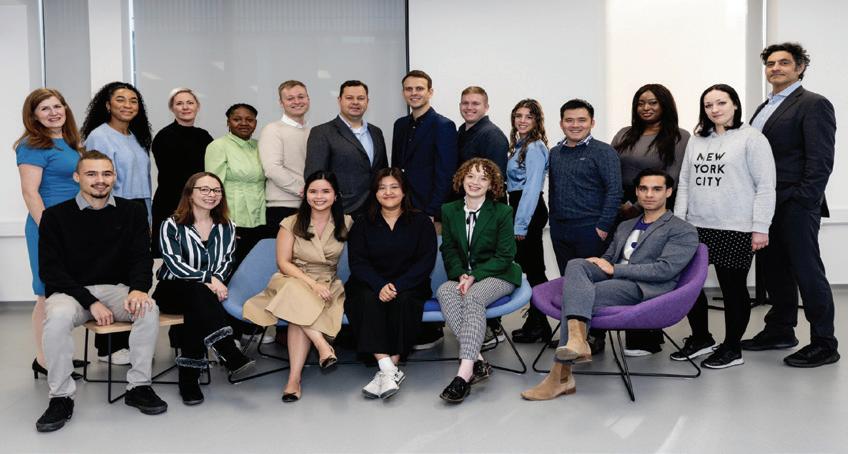
8 minute read
Capturing Opportunities
Apowerful new tool to combat climate change is carbon negative technology. CO 2 is removed from the ambient air and directed back to the underground reservoirs which once held coal, oil, and gas. There is already a big investment yp substitute wood pellets for coal and then sequester the CO2.
The split by process is:
• Bioenergy and Carbon Capture and Sequestration (BECCS)
• Blue Hydrogen
• Rare Earth Recovery
• Waste to Energy and other applications
This prediction will surprise advocates of green hydrogen who expect ultrapure water filtration systems for electrolyzers to be the biggest market.
Beccs
According to IEA, bioenergy with carbon capture and storage (BECCS) involves any energy pathway where CO2 is captured from a biogenic source and permanently stored. Only around 2 Mt of biogenic CO2 are currently captured per year, mainly in bioethanol applications. Plans for around 20 facilities together capturing around 15 Mt CO2 per year of biogenic emissions have been announced since January 2022.
Based on projects currently in the early and advanced stages of deployment, carbon removal via BECCS could reach just under 50 Mt CO2/ year by 2030, which falls far short of the approximately 190 Mt CO2/year removed through BECCS by 2030 in the net zero emissions (NZE) by 2050 scenario. Targeted support for carbon dioxide removal (CDR), and BECCS in particular, will be required to translate recent momentum into operational capacity.
Filtration and separation can be divided into initial and liquefied gas quality. Precipitators and scrubbers, along with fabric filters are used for the initial treatment. They reduce particulate to 15 mg/Nm3 or less. This would meet air pollution standards but is not good enough for transporting CO2. A second set of filters such as is used ahead of air compressors is needed. In addition, mercury must be reduced to very low levels for corrosion purposes. Activated carbon is used but a new technology using ionic liquids is also being employed.
There has been a big development in carbon capture. MHI has developed a CO 2 absorber which with an efficiency of 99%.
Blue Hydrogen
If oil, coal, or natural gas is converted to hydrogen and the CO2 sequestered, it is considered blue hydrogen. The economics are favorable to frst gemerate ammonia which is hydrogen plus nitrogen and is easily transported. The hydrogen can be extracted at the point of use. This is particularly advantageous where there are long distances between the source and use. Ammonia is chosen as the most economical method to transport hydrogen. Yara has converted natural gas to ammonia in Australia and is committed to ship millions of tons to Japan for use in power generation.
Rare Earth Recovery
A process called insitu rare earth recovery has been overlooked, but ironically it was well known to coal fired scrubber system suppliers in the 1970s. Many pre-scrubbers were employed to remove particulate and HCl.
These scrubbers ended up with rare earths leached out of the fly ash. The metals were considered a contaminant and no attempt was made to use them.
Recently the U.S. and China have realized that extracting rare earth from fly ash can be less expensive than natural ore mining. Hundreds of millions of dollars have been spent to prove that the extraction will be economical for many coals. The big problem is the large amount of energy required to pulverize fly ash.
By contrast, the insitu accidental process not only avoids the need for pulverizing but also creates the leaching fluid at no cost.
Waste to Energy
There are 2700 waste to energy plants around the world and soon there will be 3000. They are en closed in ski hills, golf courses and other attractive settings. The air emissions are very low thanks to efficient air pollution controls. These plants generate electricity while greatly reducing the waste volume to non combustible matter.
Several projects are under way to employ CCS. In the UK the government is building a CO2 pipeline throughout the country, so a WTE plant does not have to invest in its own pipeline.
Summary: Carbon capture and sequestration is an economical way to offset carbon emissions from sources which can not be controlled. The only other carbon negative technology is Direct Air Capture. This approach is very expensive and involves a carbon absorber 100 times larger than those used to capture CO2 from processes.
INDA Appoints Dan Noonan as New Director of Memberships and Business Development
INDA, the Association of the Nonwoven Fabrics Industry, has named experienced sales and business development professional, Dan Noonan, as its new Director of Memberships and Business Development.
Noonan brings 20 years of experience leading sales teams across the U.S. at Localedge/ Hearst Media Services.

Noonan will be responsible for enhancing the value of INDA membership and its industry supporting programs. He will work with staff, leadership, and members to identify and expand opportunities to enhance INDA’s programs, services and relevance to the industry.
“We are pleased to have Dan on board at INDA. Dan will surface opportunities which boost the value of INDA membership while supporting our mission for industry growth,” said Tony Fragnito, INDA President & CEO.
“I’m excited to join the team at INDA. I’ve already found that this is an amazing group that is dedicated to both our members and the industry as a whole. I’m really looking forward to connecting with our membership to learn more about their individual needs and what role INDA can play in delivering value to them.”
Noonan holds a bachelor’s degree in marketing from Providence College. He may be reached at dnoonan@inda.org. www.inda.org
London to Install Air Filters in Schools
London, UK Mayor Sadiq Khan has announced plans to fit PM2.5 filters in 200 schools, aiming to improve air quality for children’s health, with potential for wider implementation if successful. The pilot is expected to cost £2.7m and forms part of the mayor’s 2024/25 budget. The funding will pay for the filters and their maintenance, school engagement, educational materials and monitoring the impact of the program, City Hall said. www.london.gov.uk

GEA Invests EUR 18 Million in Technology Center for Alternative Proteins in the USA

GEA is investing EUR 18 million (USD 20 million) in a technology center for alternative proteins in Wisconsin, USA. The new food tech hub will pilot microbial, cell-based and plant-based foods. GEA’s state-of-the-art technologies and a team of biotechnology experts form the basis for scaling new food for industrial production, which is increasingly in demand in the USA. Groundbreaking at the new GEA campus in Janesville is scheduled for spring of 2024, with the opening to follow one year later.
The USA is one of the countries promoting the development of sustainable food options through favorable regulation and openness to innovative food technologies. For example, the Food and Drug Administration (FDA) already approved cell-cultivated chicken meat in 2022 and last year confirmed that the use of precision-fermented milk proteins in foods is safe. www.gea.com
Filter King LLC Announces Opening of 100,000-Square-Foot Manufacturing Facility
Filter King LLC, a leading manufacturer of HVAC home and business air filters, announced the opening of a new manufacturing facility in Miami, Florida. The 100,000-square-foot facility, which includes production, warehousing, and distribution, as well as the company’s corporate headquarters, was precipitated by surging demand for its premium quality air filters, and high growth expectations for 2024 and beyond.
Filter King’s products are sold through multiple channels, including, direct-to-consumer (D2C) e-commerce marketplaces and filterking.com, as well as commercial sales to condominiums, property management companies, schools, hospitals, government facilities, and HVAC service providers. www.filterking.com
Suez Secures Water Treatment Plant Project in Indonesia
SUEZ, a leading player in water management, recently signed a contract for the Buaran III Water Treatment Plant (WTP) project in Jakarta. The group will supply key equipment for the water treatment process and will provide technical advisory services for the installation and commissioning of the Buaran III utility. The new WTP in the Indonesian capital will enhance the resilience of the city’s water supply system to provide a safe, reliable, and long-term supply of water to local communities.
Currently, Jakarta’s WTPs can treat 1.47 million cubic meters daily, supplying 65% of urban areas with clean water. The city’s government is aiming for total urban clean water coverage of 100% by 2030, planning new WTPs to meet rising demand with an additional 960,000 cubic meters per day. The completion of the Buaran III WTP, expected in first half of 2025, will boost progress towards this goal. It will provide an additional 260,000 cubic meters of clean water per day to communities in Jakarta, accounting for approximately 28% of the incremental water capacity needed to meet the 2030 target. www.suez.com

Radhika Fox Appointed Senior Advisor at Xylem
Xylem Inc., a leading global water technology company dedicated to solving the world’s most challenging water issues, announced the appointment of Radhika Fox as Senior Advisor to the company.
“Radhika is one of the world’s most insightful and effective champions of water – a universally respected voice for solutions to society’s biggest water challenges,” said Matthew Pine, Xylem president and CEO.
DuPont Membranes Named 2024 Edison Awards™ Finalist

DFox will provide strategic counsel to Xylem on evolving issues and opportunities in the water sector and provide advice on a range of matters to support the delivery of Xylem’s strategy. Fox most recently served as the Senate-confirmed Assistant Administrator for the US Environmental Protection Agency’s Office of Water, acting as chief advisor to the EPA Administrator and White House on water resources and water infrastructure in the United States.
Prior to joining the EPA, Fox served as the Chief Executive Officer for the US Water Alliance, a non-partisan network that unites diverse stakeholders on common-ground solutions to the nation’s pressing environmental, water, and climate challenges. Her career in water began at the San Francisco Public Utilities Commission – a public agency that provides water, wastewater, stormwater, and electric power services to over 2.6 million people in the San Francisco Bay Area. www.xylem.com
Puraffinity Wins Award
PuPont announced that FilmTec™ LiNEXD nanofiltration membrane elements, the company’s first offering dedicated to lithium brine purification, was named a finalist in the 2024 Edison Awards™ in the Resource Recovery & Environmental Conservation category.
Lithium brine purification is critical to producing batteries needed for electrification to help combat climate change. FilmTec™ LiNE-XD elements can help enable lithium production from resources such as salt lake brine, geothermal brine, and surface and subsurface clay. FilmTec™ LiNE-XD nanofiltration membrane elements are designed to withstand harsh conditions while also yielding high recovery of both lithium and water; requiring less energy than other methods.
The Edison Awards™ is an annual competition honoring excellence in new product and service development, marketing, human-centered design, and innovation. The gold, silver and bronze winners will be announced at the 2024 Edison Awards Gala in Fort Myers, Florida, on April 18, 2024. www.dupont.com uraffinity, which develops precision technology for the removal of PFAS ‘forever chemicals’ across multiple water treatment applications, has won a $250,000 award from the Morgan Stanley Institute for Sustainable Investing.
In addition to the financial award, Puraffinity receives a yearlong collaboration with the Institute for Sustainable Investing which will help them grow and scale up their innovative solution.

Puraffinity, which is tackling the human health and environmental challenges of per-and polyfluoroalkyl substances (PFAS) has developed a suite of adsorbent materials, exhibiting high selectivity towards diverse PFAS compounds. These are adaptable for multiple applications. The company has a goal to provide one billion people with PFASsafe water by 2030. www.puraffinity.com
FTS and Jewett Automation Merge
As of February 1, 2024, Filtration Technology Systems (“FTS”) has merged with Jewett Automation, LLC of Richmond, Virginia. This business merger is part of an ongoing efforts to be the leading filtration automation business by offering best-inclass standard products, unique custom automation solutions, superior customer service and dedicated aftermarket support, the company said. FTS will continue to operate as Filtration Technology Systems. www.filtrationtech.com

















